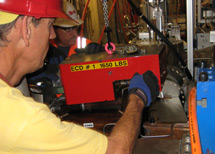
Handy Links
SLAC News Center
SLAC Today
- Subscribe
- Archives: Feb 2006-May 20, 2011
- Archives: May 23, 2011 and later
- Submit Feedback or Story Ideas
- About SLAC Today
SLAC News
Lab News
- Interactions
- Lightsources.org
- ILC NewsLine
- Int'l Science Grid This Week
- Fermilab Today
- Berkeley Lab News
- @brookhaven TODAY
- DOE Pulse
- CERN Courier
- DESY inForm
- US / LHC
SLAC Links
- Emergency
- Safety
- Policy Repository
- Site Entry Form

- Site Maps
- M & O Review
- Computing Status & Calendar
- SLAC Colloquium
- SLACspeak
- SLACspace
- SLAC Logo
- Café Menu
- Flea Market
- Web E-mail
- Marguerite Shuttle
- Discount Commuter Passes
-
Award Reporting Form
- SPIRES
- SciDoc
- Activity Groups
- Library
Stanford
Around the Bay
Recovery Act Funding at Work in SSRL Upgrades
The Stanford Synchrotron Radiation Lightsource at the Department of Energy's SLAC National Accelerator Laboratory received an important boost this year, with $4.8 million in funding from the American Reinvestment and Recovery Act for repairs and upgrades during SSRL's annual three-month shutdown, and new scientific instruments in the year to come.
"The ARRA funding was a really big help; I don't know when we could have ever gotten these things done without it," said SSRL Acting Director Piero Pianetta. The funding will go toward seismic retrofits and key upgrades to SSRL's X-ray beamlines, which are used by scientists from around the world to conduct experiments in energy, materials, environmental and life sciences, accelerator physics and more.
Part of the Recovery Act funding will help SSRL develop an advanced spectroscopy facility that will allow researchers to study systems ranging from fuel cells to photosynthesis. This facility will rely critically on SSRL’s plan to bring its SPEAR3 storage ring to its maximum operating capacity of 500 milliamperes. The ring has operated at 100 mA since its commissioning in 2004, although it recently received a boost to 200 mA. Running at full capacity will increase the brightness of the facility's X-ray beamlines, making SSRL an even more valuable tool for SSRL's scientific users.
"The results of an experiment depend on how many photons you can put on a sample," said Bob Hettel, deputy director for SLAC's Accelerator Directorate. "If you can put five times as many photons on a sample, some experiments can be done five times faster."
In other experiments, where the intense beam could be harmful to experimental samples, new schemes such as rapid sample scanning and fast shutters to remove the beam from the sample between measurements will be employed.
One of the biggest challenges in reaching full operating capacity, though, is making sure that the SSRL optical devices have a reliable cooling supply. Toward this end, $800,000 in Recovery Act funds will be used to help upgrade the cooling systems on SSRL's 11 monochromators—devices that filter incoming light to a single specified wavelength.
In order to run efficiently, the monochromators must be kept cool—a task that requires some 1,000 gallons of liquid nitrogen every day. SSRL's X-ray beamlines will generate more heat once SPEAR3 is turned up to 500 mA, though, and so more liquid nitrogen will be needed to keep the temperature down in the devices. To accommodate the increased throughput, SSRL is using Recovery Act funds to install a new 11,000 gallon liquid nitrogen storage tank.
The funds will also help purchase backup power generators to keep the cooling systems running in the case of power outages. Another $3 million from the Recovery Act will be used to seismically retrofit the booster synchrotron and sections of the SPEAR3 ring.
This year's SSRL shutdown, which started August 10, will also give technicians a chance to make the safety upgrades needed before the SPEAR3 ring can start operating at higher currents. The team is installing clearing magnets to bring top off injection to Beamlines 1, 2, 8 and 14, plus new interlocks on each beamline to disable the photon beam in the unlikely case that anything goes wrong due to the increased beam power.
"When we go to higher current, there's a lot more power going down the beamline," Hettel said. The new interlock will protect users by shutting the beam off at the first indication of any stray electrons.
The shutdown will also see a number of smaller projects, including repairs to a leaky compressed air tank and to water cooling systems. It will be completed in time for the return of scientific users to SSRL on October 26.
ARRA funds will continue to deliver improvements following the end of the 2009 shutdown, funding the construction of two new spectrometers on SSRL Beamline 6-2. The new devices will allow scientists to conduct groundbreaking research in fields ranging from materials to biocatalysis. According to SSRL Senior Staff Scientist Uwe Bergmann, the instruments will be among the most efficient instruments of their kind in the world.
"All the experiments we are proposing to do are currently limited by the instrument efficiency," Bergmann said. "With these new instruments, we'll be able to tackle scientific problems that have been out of our reach."
—Nicholas Bock
SLAC Today, September 22, 2009
